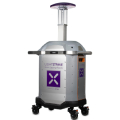The latest report from the Centers for Disease Control and Prevention (CDC) calls on us to stop referring to a coming post-antibiotic era – it’s already here [1]. Antibiotic resistance is when bacteria (pathogens) no longer respond to any of the drugs (antibiotics) used to treat infections. Since the first reported case of antibiotic resistance in 1968, bacteria have eventually developed resistance against every antibiotic that has been developed [2]. Common drugs, such as penicillin, have become ineffective at treating infections [3]. The inability to treat and prevent infections contributes to the current pandemic of bacteria resistance [1]. Globally, 700,000 people die each year from infections caused by antibiotic-resistant bacteria [4]. In 2019, the World Health Organization (WHO) released a report stating that if no action is taken, drug-resistant diseases could cause 10 million deaths each year by 2050 [4]!
The Post-Antibiotic Era is Right Now
We are progressing toward a time when bacteria have little to fear, rendering many antibiotics useless. The Organization for Economic Cooperation and Development (OECD) estimates that about 35% of common pathogens are already resistant to available treatment options [4]. Prior to 1992 antibiotic-resistant infections were very rare; now the CDC estimates that almost 3 million people a year are infected with antibiotic-resistant bacteria in the United States. [1]. On top of that, researchers have recovered bacteria from the hospital environment that are resistant to both antibiotics and disinfectants [5]. The emergence of chemical-resistant bacteria will make traditional chemical disinfectants less effective in removing pathogens from the environment [5,6].
Strategies to a Post-Antibiotic Era
The CDC recommends five strategies to fight antibiotic resistance – 1) implement pathogen mitigation and control practices, 2) track and share surveillance data, 3) implement antimicrobial stewardship programs (ASPs), 4) invest in vaccines/therapeutics, and 5) improve environmental hygiene [1]. It is important to note that developing new antibiotics is not a strategy, instead, the focus should be on pathogen mitigation to help reduce the spread of resistance. Tracking and sharing data can help identify areas for improvement and target efforts to mitigate resistance. ASPs can help drive appropriate use and reduce unnecessary use of antibiotics. Widespread use of vaccines can help prevent infections and spread. Practicing good hygiene can keep antibiotic-resistant bacteria from entering and staying in the environment [1].
There are new technologies proven to help deactivate resistant bacteria before it can be transferred from surfaces to people. Certain wavelengths of ultraviolet light (UV) are “germicidal” or capable of inactivating bacteria and other drug-resistant pathogens left behind in the environment [7]. For example, LightStrike’s Pulsed Xenon UV light technology produces UV across the entire germicidal spectrum (200-315 nm), deactivating pathogens at the wavelengths where they are most susceptible. This technology is being used at ~1,000 hospitals around the world. The pulsed, high intensity, broad spectrum nature of LightStrike’s UV light is the only UV light technology supported by over 45 research studies validating its effectiveness in deactivating a wide variety of pathogens, including C. diff, MRSA, Candida auris, CRE, VRE, SARS-CoV-2, and more [8].
Talking about the threat of drug-resistant pathogens is a bit daunting, but we are also in a place where we can have an impact on the future if we take steps now. The healthcare community can attack this threat from many different angles and disinfection is a prominent one.
References:
1.The Centers for Disease Control and Prevention (CDC). Antibiotic Resistance Threats in the United States, 2019. Retrieved from: https://www.cdc.gov/drugresistance/biggest-threats.html
2. Fair RJ, Tor Y. Antibiotics and bacterial resistance in the 21st century. Perspectives in medicinal chemistry. 2014, PMC-S14459.
3. Mendelson M. Financial Times. January 21, 2021. https://www.ft.com/content/520b0300-1717-4f66-b792-f2f7da7112a3
4. The World Health Organization (WHO). No Time to Wait: Securing the future from drug-resistant infections. 2019. Retrieved from: https://www.who.int/antimicrobial-resistance/interagency-coordination-group/IACG_final_report_EN.pdf?ua=1. January 2021.
5. Guo W, Shan K, Xu B, Li J. Determining the resistance of carbapenem-resistant Klebsiella pneumoniae to common disinfectants and elucidating the underlying resistance mechanisms. Pathogens and global health. 2015 Jun 1;109(4):184-92.
6. Tezel U, Pavlostathis SG. Quaternary ammonium disinfectants: microbial adaptation, degradation and ecology. Current opinion in biotechnology. 2015 Jun 1;33:296-304.
7. Illuminating Engineering Society. IES Committee Report: Germicidal Ultraviolet (GUV) – Frequently Asked Questions. 2020. Retrieved from: https://media.ies.org/docs/standards/IES-CR-2-20-V1-6d.pdf, January 2021.
8. xenex.com/studies

















